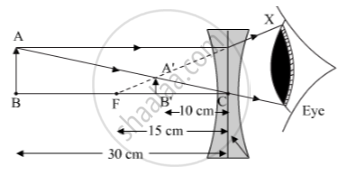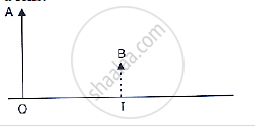Advertisements
Advertisements
प्रश्न
A concave lens of focal length 15 cm forms an image 10 cm from the lens. How far is the object placed from the lens? Draw the ray diagram.
उत्तर
Focal length f = −15 cm ...(negative due to sign convention)
Image distance v = −10 cm ...(negative due to sign convention)
Object distance u = ?
Applying the lens formula:
`1/"f" = 1/"v" - 1/"u"`
⇒ `1/"u" = 1/"v" - 1/"f"`
⇒ `1/"u" = 1/(-10) - 1/(-15)`
⇒ `1/"u" = -1/10 + 1/15`
⇒ `1/"u" = (-3 + 2)/30`
⇒ `1/"u" = (-1)/30`
u = − 30 cm
The object should be placed at a distance of 30 cm from the concave lens and on the left side.

APPEARS IN
संबंधित प्रश्न
Where must the object be placed for the image formed by a converging lens to be:
real, inverted and smaller than the object?
Where must the object be placed for the image formed by a converging lens to be:
real, inverted and larger than the object?
Draw a diagram to show how a converging lens focusses parallel rays of light?
An object 2 cm tall stands on the principal axis of a converging lens of focal length 8 cm. Find the position, nature and size of the image formed if the object is:
(i) 12 cm from the lens
(ii) 6 cm from the lens
State one practical application each of the use of such a lens with the object in position (i) and (ii).
Copy and complete the diagram below to show what happens to the rays of light when they pass through the concave lens:
An object lies at a distance of 2f from a concave lens of focal length f. Draw a ray-diagram to illustrate the image formation.
Give the position, size and nature of image of formed by a concave lens when the object is placed:
anywhere between optical centre and infinity.
How would a pencil look like if you saw it through
a concave lens Is the image real or virtual?
When an object is kept at any distance in front of a concave lens, the image formed is always:
(a) virtual, erect and magnified
(b) virtual, inverted and diminished.
(c) virtual, erect and diminished
(d) virtual, erect and same size as object
When sunlight is concentrated on a piece of paper by a spherical mirror or lens, then a hole can be burnt in it. For doing this, the paper must be placed at he focus of:
(a) either a convex mirror or convex lens
(b) either a concave mirror or concave lens
(c) either a concave mirror or convex lens
(d) either a convex mirror or concave lens
When an object is placed 10 cm in front of lens A, the image is real, inverted, magnified and formed at a great distance. When the same object is placed 10 cm in front of lens B, the image formed is real, inverted and same size as the object.
What is the nature of lens A?
The power of a concave lens is 10 D and that of a convex lens is 6 D. When these two lenses are placed in contact with each other, the power of their combination will be :
(a) +16 D
(b) +4 D
(c) −16 D
(d) −4 D
The following diagram in given below shows an object OA and its virtual image IB formed by a lens.

A concave lens forms the image of an object which is ______.
How will you differentiate between a convex and a concave lens by looking at
- a distant object,
- a printed page?
Explain the working of an astronomical telescope using refraction of light.
Distinguish between concave and convex lens.
Copy the following figure and complete it to show the formation of the image of the object AB. Name the lens used in the figure.

Draw images in case of a concave lens when the object is at any point on the principal axis between the lens and infinity.
The focal length of a lens is negative. In this case, state the kind of lens.
